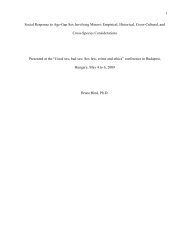Infant and Child Sexuality: A Sociological Perspective - Ipce
Infant and Child Sexuality: A Sociological Perspective - Ipce
Infant and Child Sexuality: A Sociological Perspective - Ipce
Create successful ePaper yourself
Turn your PDF publications into a flip-book with our unique Google optimized e-Paper software.
questions about his penis. He watched it bounce up <strong>and</strong> down when he<br />
sucked in. He got an erection under water running into the tub when<br />
taking a bath. Perhaps one day in seven he would stimulate himself intensely.<br />
Three days in the week he might explore or stimulate his genitals<br />
slightly to moderately, <strong>and</strong> the other three days direct little<br />
attention to them. At times he could be quite “seductive.” He suggested<br />
to his mother that she squeeze his penis; she distracted him. On<br />
occasion he put his favorite inanimate companion, his “doggie” between<br />
his thighs <strong>and</strong> squeezed several times. He had a partial erection. He<br />
began to distinguish between what boys <strong>and</strong> girls looked like. He was<br />
especially affectionate toward other infants.<br />
It cannot be assumed, of course, that behavior that appears to be<br />
erotic to adults is actually erotic in the consciousness of the infant<br />
since the infant lacks the well developed erotic imagery that is available<br />
<strong>and</strong> so important in adult sexual activity. Also in the sexual<br />
realm, sociocultural influences come to so modify <strong>and</strong> interpret biological<br />
influences that a straight-line developmental continuity from infancy<br />
to maturity cannot be assumed. (Simon <strong>and</strong> Gagnon, March 1969). In<br />
societies that take a tolerant <strong>and</strong> permissive attitude toward erotic<br />
expression in infancy, fingering the genitals becomes an established<br />
habit of occasional occurrence. (Ford <strong>and</strong> Beach, 1951, p. 188). One of<br />
any number of examples that can be given is that of the Marquesa. Sex<br />
play was common practice from the earliest ages among the Marquesa <strong>and</strong><br />
not only tolerated but encouraged. (Kardiner, 1939, p. 205-206). They<br />
recognized the erotic impulse in childhood <strong>and</strong> accorded it the right of<br />
free exercise. They eroticized the child by masturbating it to keep it<br />
quiet. In the case of the girls, labia were manipulated as a placebo,<br />
but also to encourage the growth of large labia, which to the Marquesans<br />
was a mark of beauty. Such activity was, no doubt, also erotically<br />
stimulating. There was social recognition of all sexual activity<br />
in childhood, <strong>and</strong> there were no restrictions against encouragement to<br />
exercise it freely; it was allocated the same place in the child’s<br />
world that it occupied in the adult’s.<br />
In sum, there is sufficient evidence to show a capacity for specific<br />
<strong>and</strong> intense somato-sensory activity occurring in both male <strong>and</strong><br />
female infants. A sensory response system is present beginning in the<br />
early prenatal period. It is necessary to life itself. Some zones of<br />
the body are more responsive to stimulation than are others even in the<br />
first year of life--the so-called erogenous zones--mouth, anus, genitalia.<br />
The capacity for specific response to stimulation develops over<br />
time with more at each age level responding to genital stimulation.<br />
(Gagnon, August 1965). So the infant has the capacity for erotic activity.<br />
He needs to learn how to utilize that capacity as an aspect of<br />
personality, as a part of his fantasy life, <strong>and</strong> as a resource in interpersonal<br />
relationships.<br />
<strong>Infant</strong>-Other Interaction<br />
During the first several years of life the infant’s relationship to<br />
others centers mostly on relationships with the mother (or a mother<br />
substitute) <strong>and</strong> involves having physiological needs met--most<br />
especially the need for food. Feeding is necessary to survival; but<br />
feeding is also an occasion for intimate contact with other persons as<br />
a part of the infant’s exploration of the environment. Objects are<br />
8
















